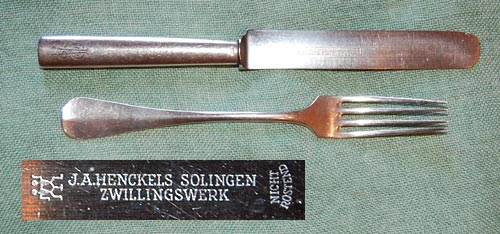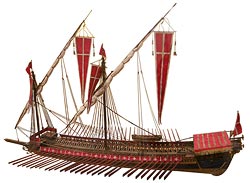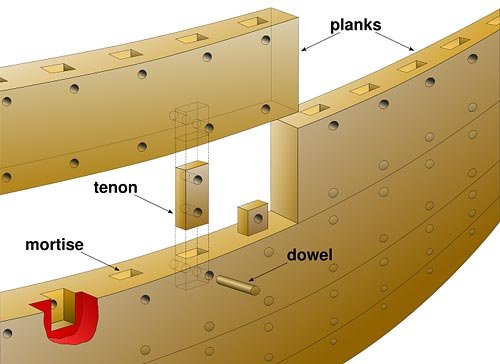Sometimes we need a reminder to realize the triumphs of Science and Engineering that went into the most common everyday objects. Take our ubiquitous stainless steel cutlery: what was it like when this recent addition to materials science – and our dinner table – suddenly made rust a non-issue?

Check out a somewhat quirky tour of this story of progress in the latest article on my Possibly Interesting web site!
Used to be, at the beginning of every (face to face) meeting ten minutes would be wasted on getting the slide projector going. Today many meetings are virtual, but the same time is still wasted while people try to log into the shared meeting workspace…
A case in point: I’ve just participated in a meeting using WebEx to share documents across the world. Nice. But the meeting started ten minutes late, because it took me that time to wade through the invitation email and figure out what I had to do. Now, I’m not perfect, but I’m an experienced IT engineer… so what was this delay about?
The meeting invite email (which was quite lengthy, and included no less than seven links, of which I only needed two) told me to dial into a tollfree phone number to join the audio part. When I did that I was cheerfully welcomed by a machine that told me to dial my “access code or meeting number followed by the pound sign”. I started to scan the email frantically looking for a meeting number or an access code; none were to be seen. The message contained various long numbers, mostly inside the link URLs, so I tried those in random order. The one that finally worked was the last one I tried (naturally) and it was the number the message referred to as my “Session number“.
So yes, maybe I’m naive, but if they want me to dial a session number, couldn’t the recording say “Please dial your session number“? Or, better yet, “Please dial the session number found near the top of your invitation email”?
I was checking some French using Google translator, and discovered that – contrary to my French teacher’s insistence back in high school – “La langue Francaise” means “English language”!
Of course one doesn’t expect perfection from machine translation, but this was different than the usual silly mistakes: a translation program ought to know the meaning of the name of a language it translates, after all. So can it be that Google, in its staggering growth to encompass all knowledge, has finally reached true intelligence and reasoned that the above translation is correct on some higehr level – the way Douglas Hofstadter pointed out in his immortal “Godel, Escher, Bach” that “Borscht“, when translated from the Russian, may need to be converted to “Campbell soup” to convey its ubiquity in the respective culture?
Nah… not likely. I actually played a little more – for instance, “La langue Francaise” in Italian, according to Google, means “Lingua inglese“, not “Lingua Italiana“. I suppose by posing such questions to the program one could map where the problem lies in its cognitive functions, like one tries to localize brain damage in a patient by mapping input/output relationships in an interview. So is Google Translator a conscious entity after all, albeit a brain-damaged one? 🙂
Here then is my sleek Nokia E71, and I really like it overall. But nobody’s perfect, right?…
 Take the calendar application that came on this handheld. It has a number of shortcomings (more on these later) and one amusing quirk: most of the time when you click the calendar button it displays an empty screen with the phrase (no entries) at the center. Then, less than a second later, the actual entries for the day (in my hectic life, alas, there are always entries…) show up.
Take the calendar application that came on this handheld. It has a number of shortcomings (more on these later) and one amusing quirk: most of the time when you click the calendar button it displays an empty screen with the phrase (no entries) at the center. Then, less than a second later, the actual entries for the day (in my hectic life, alas, there are always entries…) show up.
Obviously there are two routines involved, one to query the database for entries, the other to display “no entries” if there are none. It would take a minute to code it so the second routine would wait for the first to complete before shooting its big mouth off… and it would take the most rudimentary QA to discover this issue.
Sloppy!
Yesterday I went to the annual conference of the Israeli Society for History and Philosophy of Science, an eclectic event if ever I saw one. Lectures covered such diverse issues as the possible role of quantum effects in neuronal microtubules in creating consciousness (yes, Penrose’s conjecture); blog writing as a therapeutic tool for adolescents with social and emotional problems; the development of the Theremin; and a lot besides. It was so much fun that I joined the society then and there!
 But to the subject of this blog: there was a lecture by Yossi Eliav about The evolution of engineering literacy as seen in Venetian manuscripts about shipbuilding from the 15th century. This mouthful was actually very interesting; but at some point I asked a question about older ships and I was treated to the following insight: these Venetians had large rowing ships (right), galleys, carrying over 100 rowers, which were produced in large numbers and used extensively for centuries; so did the Romans, Carthaginians and Greeks 20 centuries earlier. But the Roman and Greek galleys – triremes, with 3 rows of rowers – were of a completely different, and far superior, construction!
But to the subject of this blog: there was a lecture by Yossi Eliav about The evolution of engineering literacy as seen in Venetian manuscripts about shipbuilding from the 15th century. This mouthful was actually very interesting; but at some point I asked a question about older ships and I was treated to the following insight: these Venetians had large rowing ships (right), galleys, carrying over 100 rowers, which were produced in large numbers and used extensively for centuries; so did the Romans, Carthaginians and Greeks 20 centuries earlier. But the Roman and Greek galleys – triremes, with 3 rows of rowers – were of a completely different, and far superior, construction!
The medieval and early modern ships were built from the inside out: first the keel and ribs were built, and then planks were nailed to this skeleton from the outside. The ancient trireme was built from the outside in: first the shell was built from planks connected to each other with mortise and tenon joints; then the inner skeleton was added as reinforcement. This meant that the trireme had a solid hull that could withstand shearing forces, which the Venetian galleys could not. In addition, the precision of the Greek and Roman work was such that the hull was practically watertight even without caulking!
The picture below shows this amazing technique in detail.
These ancients could sure build!

Photo credits:
Maltese galley: Myriam Thyes, via Wikimedia Commons.
Trireme construction: Eric Gaba, via Wikimedia Commons.
Last year I posted about FameLab, the science communication competition organized by the British Council in the Jerusalem Science Museum. Well, here it comes again, and today I’m a judge again. Like before, we get treated to a group of fine young students presenting diverse scientific subjects in only 3 (yes, three!) minutes each. Fascinating!
I also learned an interesting thing: the British Council is working hard to empower the winners to propagate science knowledge. Not only do they receive presentation skills training, they also get to attend international get together where winners from diverse countries meet face to face to exchange views, learn from each other, and figure ways to promote Science education. This is really a wonderful program!

 Take the calendar application that came on this handheld. It has a number of shortcomings (more on these later) and one amusing quirk: most of the time when you click the calendar button it displays an empty screen with the phrase (no entries) at the center. Then, less than a second later, the actual entries for the day (in my hectic life, alas, there are always entries…) show up.
Take the calendar application that came on this handheld. It has a number of shortcomings (more on these later) and one amusing quirk: most of the time when you click the calendar button it displays an empty screen with the phrase (no entries) at the center. Then, less than a second later, the actual entries for the day (in my hectic life, alas, there are always entries…) show up. But to the subject of this blog: there was a lecture by Yossi Eliav about The evolution of engineering literacy as seen in Venetian manuscripts about shipbuilding from the 15th century. This mouthful was actually very interesting; but at some point I asked a question about older ships and I was treated to the following insight: these Venetians had large rowing ships (right), galleys, carrying over 100 rowers, which were produced in large numbers and used extensively for centuries; so did the Romans, Carthaginians and Greeks 20 centuries earlier. But the Roman and Greek galleys – triremes, with 3 rows of rowers – were of a completely different, and far superior, construction!
But to the subject of this blog: there was a lecture by Yossi Eliav about The evolution of engineering literacy as seen in Venetian manuscripts about shipbuilding from the 15th century. This mouthful was actually very interesting; but at some point I asked a question about older ships and I was treated to the following insight: these Venetians had large rowing ships (right), galleys, carrying over 100 rowers, which were produced in large numbers and used extensively for centuries; so did the Romans, Carthaginians and Greeks 20 centuries earlier. But the Roman and Greek galleys – triremes, with 3 rows of rowers – were of a completely different, and far superior, construction!


The Sweep Hand and the concept of Time
I met a guy who had an old Swiss chronometer watch, a self-winding mechanical one. As I looked at it, admiring the fine workmanship, I suddenly noticed a detail that used to be taken for granted: the thing had a seconds hand that was moving around the face of the watch.
So, it was moving, not in the swift jerky jumps we’re so used to in today’s superbly accurate Quartz watches. This hand moved at a constant rate, sweeping around the watch, which is why it used to be called a “sweep hand” back then. I remember this from my father’s watch when I was a small child: I would try in vain to discern any movement in the hours and minutes hands, but the sweep hand moved in its slow, stately march, signaling the inexorable continuity of time.
And it occurred to me that the switch from mechanical to electronic analog watches makes the seconds hand mirror the zeitgeist of their respective periods in history. The jumpy quartz-driven hand is such a great fit to the hectic, jerky pace of our modern life, whereas the sweep hand is a better reflection of the more sedate lifestyle of centuries past…